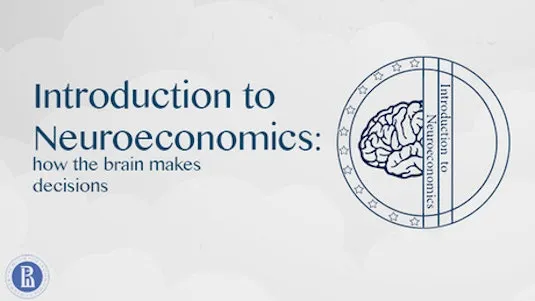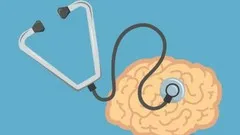
Introduction to Neuroeconomics: How the Brain Makes Decisions 
Neuroeconomics is a new field of study that combines economics, psychology, and neuroscience to better understand how the brain makes decisions. By creating a unified theory of decision-making, Neuroeconomics seeks to explain the complex behavior of humans. ▼
ADVERTISEMENT
Course Feature
![]() Cost:
Cost:
Free
![]() Provider:
Provider:
Coursera
![]() Certificate:
Certificate:
Paid Certification
![]() Language:
Language:
English
![]() Start Date:
Start Date:
28th Feb, 2022
Course Overview
❗The content presented here is sourced directly from Coursera platform. For comprehensive course details, including enrollment information, simply click on the 'Go to class' link on our website.
Updated in [March 06th, 2023]
This course provides an introduction to Neuroeconomics, a unified discipline of economics, psychology, and neuroscience. Students will gain a deeper understanding of how they make their own decisions and how others decide. Neuroscience, when allied with psychology and economics, creates powerful new models to explain why we make decisions. Neurobiological mechanisms of decision-making, decisions under risk, trust and cooperation will be central issues in this course. The course does not require any prior study of economics and neuroscience; however, it might require students to study novel interdisciplinary materials. The course provides an introduction to the methodology, assumptions, and main findings of Neuroeconomics.
During each video, students will have to answer some relevant questions. At the end of each module, students must complete a quiz consisting of 15 questions. To pass the course, students must reach a satisfactory standard in all the course modules by completing all graded quizzes and the final exam. In addition to watching video lectures and taking quizzes, students will receive an invitation to join the forum.
Technical problems? Write to us: [email protected]
[Applications]
Upon completion of this course, students will have a better understanding of the methodology, assumptions, and main findings of Neuroeconomics. They will be able to apply this knowledge to their own decision-making processes and to further develop their skills in the field of Neuroeconomics. Additionally, they will have access to supplementary videos to gain insight from leading experts in the field. Finally, they will have the opportunity to join a forum to discuss the topics covered in the course.
[Career Paths]
1. Neuroeconomist: Neuroeconomists are experts in the field of Neuroeconomics, which combines economics, psychology, and neuroscience to create powerful models to explain human decision-making. Neuroeconomists use brain-imaging techniques such as fMRI and TMS to study the neural mechanisms of decision-making, and develop models to explain how people make decisions. This field is rapidly growing, and there is a high demand for Neuroeconomists in both academia and industry.
2. Neuropsychologist: Neuropsychologists specialize in the study of the brain and behavior. They use a variety of techniques, including brain-imaging, to study the neural mechanisms of decision-making and develop models to explain how people make decisions. Neuropsychologists are in high demand in both academia and industry, and the field is rapidly growing.
3. Behavioral Economist: Behavioral economists specialize in the study of how people make decisions. They use a variety of techniques, including brain-imaging, to study the neural mechanisms of decision-making and develop models to explain how people make decisions. Behavioral economists are in high demand in both academia and industry, and the field is rapidly growing.
4. Data Scientist: Data scientists specialize in the analysis of large datasets to uncover patterns and insights. They use a variety of techniques, including machine learning and artificial intelligence, to analyze data and develop models to explain how people make decisions. Data scientists are in high demand in both academia and industry, and the field is rapidly growing.
[Education Paths]
Recommended Degree Paths:
1. Bachelor of Science in Neuroscience: This degree program provides students with a comprehensive understanding of the brain and nervous system, including the structure and function of neurons, the development of the nervous system, and the effects of drugs and other substances on the brain. Students will also learn about the latest research and technologies used in neuroscience, as well as the ethical implications of this research. This degree is ideal for those interested in pursuing a career in neuroscience, such as a research scientist, clinical neurologist, or neuropsychologist.
2. Master of Science in Neuroeconomics: This degree program provides students with an in-depth understanding of the principles of economics and neuroscience, and how they can be applied to decision-making. Students will learn about the latest research and technologies used in neuroeconomics, as well as the ethical implications of this research. This degree is ideal for those interested in pursuing a career in neuroeconomics, such as a research scientist, financial analyst, or consultant.
3. Doctor of Philosophy in Neuroeconomics: This degree program provides students with an advanced understanding of the principles of economics and neuroscience, and how they can be applied to decision-making. Students will learn about the latest research and technologies used in neuroeconomics, as well as the ethical implications of this research. This degree is ideal for those interested in pursuing a career in neuroeconomics, such as a research scientist, financial analyst, or consultant.
4. Master of Business Administration in Neuroeconomics: This degree program provides students with an understanding of the principles of economics and neuroscience, and how they can be applied to business decision-making. Students will learn about the latest research and technologies used in neuroeconomics, as well as the ethical implications of this research. This degree is ideal for those interested in pursuing a career in business, such as a financial analyst, consultant, or executive.
Developing Trends:
1. Neuroeconomics is becoming increasingly popular as a field of study, with more universities offering courses and degree programs in the subject.
2. Neuroeconomics is becoming more interdisciplinary, with researchers from different fields collaborating to gain a better understanding of decision-making.
3. Neuroeconomics is becoming more data-driven, with researchers using data from brain-imaging techniques to gain insights into decision-making.
4. Neuroeconomics is becoming more accessible, with more online courses and resources available to those interested in the field.
Course Syllabus
Introduction to the Course
Welcome to the new field of Neuroeconomics!Introduction and Scope of Neuroeconomics
Neuroanatomy, Neurophysiology, and Neuroimaging: Tools of Neuroeconomics
I hope you have an opportunity to reserve some time to explore the course content, course logic and our grading policy. The course consists of nine lectures covering main topics of Neuroeconomics. This class is completely self-paced: You can learn as fast as you like.The course does not require any prior study of economics and neuroscience; however, it might require you to study novel interdisciplinary materials. The course provides an introduction to the methodology, assumptions, and main findings of Neuroeconomics. Our students have different backgrounds; therefore, I have adapted and simplified the course to allow all students to understand the interdisciplinary content. This course will help you to start your progress in the field of Neuroeconomics and to further develop your skills during other more advanced courses and trainings in the future.Have a good time with this new field of science!Introducing Brain Models of Decision-Making and Choice
Neural Representation of Subjective Value
Best regards,Affective Mechanisms of Decision-Making
Vasily KlucharevDual Process Theory of Decision-Making: Toward a Neuroeconomics Perspective
This lecture will provide an introduction to the course and a historical overview of the field and will explore major assumptions of Neuroeconomics. We'll discuss the need for Neuroeconomics and the limitations of the traditional fields of economics, psychology, and neuroscience. Can we predict decisions based on neural activity? Can we change human decisions using brain stimulation techniques? Does Neuroeconomics change views on free will and free decisions? This lecture will deal with these and other questions. Overall, I'll try to convince you that Neuroeconomics radically transforms the way we normally think about human behavior. Have a good time with a new field of science!Decision-Making under Risk: Toward a Neuroeconomics Mechanism
We will start with a short introduction to cognitive neuroscience, brain anatomy, and brain functions and continue with a discussion of various methods of measuring brain activity, including brain imaging methods (EEG, MEG, fMRI), transcranial brain stimulation (TMS), cell recording, and data visualization, and interpretation of the results. The main goal of this lecture is to help you read and understand results of Neuroeconomics papers. I will introduce terminology and experimental methods that we will use throughout the whole course.The Social Brain: Games in the Brain
Now we will start our journey in Neuroeconomic theories and findings. You will learn the main features of the Diffusion Model, the most popular theoretical model of decision-making in Neuroeconomics. We will apply this model to single-neuron activity in a monkey cortex and to the human brain in order to understand how brains program decisions. For advanced students, I recommend a guest lecture provided by Dr. Sebastian Horn (Max Planck Institute for Human Development, Berlin), who gives a more fundamental explanation of the drift diffusion model. Enjoy Neuroeconomics!Evolutionary Perspective of Decision-Making
Why do we make decisions? Perhaps we do so to activate our neurons. During this lecture, we will discuss how neurons assign values to different options during the decision-making process. We will also discuss the central role of the nucleus accumbens and orbitofrontal cortex in the valuation process. To make adaptive decisions, we must evaluate the costs and benefits of available options. Neuroeconomics has set itself the ambitious goal of understanding the brain mechanisms that are responsible for these evaluative processes. Neuroeconomics has also focused on describing the neural signals related to learning the value of stimuli and actions. Overall, this lecture will present some key ideas of Neuroeconomics.Final Exam
The influence of emotions on decision-making is largely ignored in decision theories. Our objective in this lecture is to explore the role of emotion in decision-making and to introduce theories and basic findings of Neuroeconomics in this context. For example, the neuroeconomic studies of decision-making in neurological patients who can no longer process emotional information normally suggest that people make judgments based not only on evaluations of the values of options and probabilities of outcomes but often primarily on emotions.Course Provider

Provider Coursera's Stats at AZClass
Introduction to Neuroeconomics presents the methods, assumptions and key findings of neuroeconomics. It covers topics such as the neurobiological mechanisms of decision-making, decision-making under risk, trust and cooperation. It also provides complementary videos to reveal the opinions of leading experts in the field. After completing this course, you will be able to understand the interdisciplinary content of neuroeconomics and begin your progression in the field. You will also be able to further develop your skills in other more advanced courses and training in the future. To get the most out of this course, you should watch video lectures, answer related questions and complete quizzes.
Discussion and Reviews
0.0 (Based on 0 reviews)
Explore Similar Online Courses

International Leadership and Organizational Behavior

Managing Supply Chain Disruption During COVID-19

Python for Informatics: Exploring Information

Social Network Analysis

Introduction to Systematic Review and Meta-Analysis

The Analytics Edge

DCO042 - Python For Informatics

Causal Diagrams: Draw Your Assumptions Before Your Conclusions

Whole genome sequencing of bacterial genomes - tools and applications

Control Your Subconscious Mind: Neuroscience Hidden Secrets

Perform an Excellent Neurological Bedside Exam


Start your review of Introduction to Neuroeconomics: How the Brain Makes Decisions